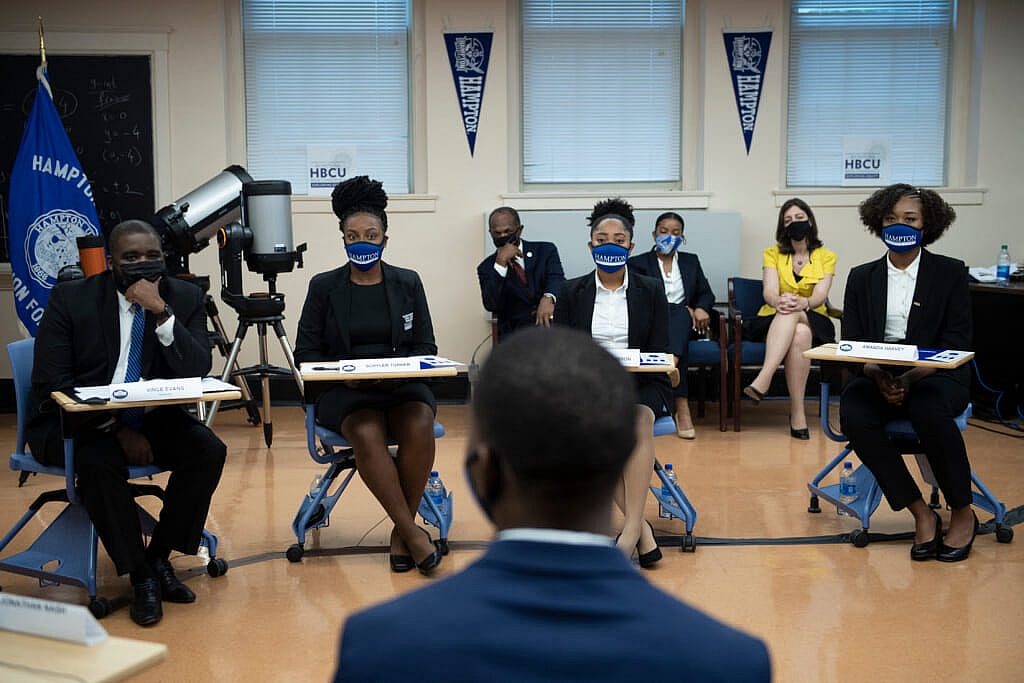The Biden-Harris administration unveiled on Thursday a massive government-wide action plan to advance racial equity across 90 federal agencies with more than 300 strategies and commitments laid out by government leaders.
The announcements from the dozens of federal agencies are the start of fulfilling an executive order signed by President Joe Biden on his first day in office to advance racial equity across the entire federal government.
In a video announcing the racial equity action plans, President Biden acknowledged that the commitments laid out by his administration must not be seen as just a “one-year project” but a “generational commitment.”
“These plans are an important step forward, reflecting the Biden-Harris administration’s work to make the promise of America real for every American,” said the president.
From the Department of Housing and Urban Development (HUD), the Department of Education to the Environmental Protection Agency, each federal agency released its action plan to advance racial equity to close the myriad gaps in services available to underserved communities.
Susan Rice, Director of the White House Domestic Policy Council, led the administration’s racial equity apparatus to ensure that all U.S. departments adhered to President Biden’s order to evaluate their agencies and implement strategies to ensure that their services reached communities that have been historically underserved and underrepresented, including Black, Latino, LGBTQ+, Tribal and rural populations.

Rice told theGrio, “It will matter in everyday lives, whether you’re trying to buy a home and want to be sure you’re not getting cheated by the home appraisal, whether you’re trying to access unemployment insurance and it’s too hard and the paperwork is too onerous.
“Whether you’re a Black mom trying to ensure that when you’re getting ready to have your child and the options for you are such that you’re not disproportionately likely to suffer adverse outcomes…[or] I’m a small business [and] I want to access federal government contracts and I want to export my products.”
She added, “All of these are things that the federal government can play a role in rectifying… What we are doing through this historic action is making sure that all of our agencies are firing on all cylinders to deliver for everybody.”
The investments made by the federal government will show up in very real and tangible ways, said Rice.
“The average American will see improvements in their ability to get unemployment insurance, their ability to get a small business loan, their ability to get a piece of the federal contract, their ability to access educational opportunities, and access health care that is affordable,” explained Rice, who previously served as National Security Advisor to former President Barack Obama.
The passion for expanding equity and opportunity runs in Rice’s blood as her late mother, Lois Rice, was known as the “mother of the Pell Grant” program as she notably lobbied for the United States Congress to pass legislation that ultimately created the popular federal financial aid program that now supports millions of American college students annually.
Rice noted that President Biden’s budget request would “ensure that the maximum Pell Grant is twice as large as it was when he took office.”
“This is just one of the ways in which we are trying to bring greater equity and opportunity to underserved communities so that people who may not otherwise have the resources to go to college, whether it’s a two-year college or a four-year college, can do so, which we all know is one of the key things that one can do to have a brighter future and have the opportunity to build wealth,” she added.
Students who attend Historically Black Colleges and Universities (HBCUs) are notably large recipients of Pell Grants, as about 70% of them rely on the financial aid program. HBCUs are a focus of some of the racial equity action plans enlisted by agencies like the Department of Education and the Department of Energy.

In addition to increasing the amount of investment in Pell Grants by the Education Department, other departments are committing to investing in educational and innovative programs targeting HBCU students. The Department of Commerce, for example, is ensuring that its U.S. Patent Office is undertaking initiatives to train students on how to navigate financial barriers in seeking intellectual property for their enterprises.
More notably, the Department of Energy is committing to increased investment in STEM research and workforce development at HBCUs (over $59 million) and investing $43 million to support apprenticeships for HBCU students and development programs for HBCU faculty at half a dozen of its national labs.
The Energy Department’s senior advisor on equity, Shalanda Baker, who helped spearhead the agency’s announced strategies, told theGrio that students will have the opportunity to research scientific data related to areas like climate change and innovation, or as Baker described doing, “the actual work with lab professionals.”
“It’s not always the sexiest stuff, but it’s an opportunity for them to really get to see how this work happens, and just get engaged so that they see that there’s a place for them at the department [and] there’s a place for them in these types of sophisticated research institutions,” said Baker. She added that it’s also an opportunity for labs to see “how great HBCUs are.”
Beyond HBCUs, the Department of Energy is also focusing on other areas like ensuring that Black and Brown communities are better prepared for the effects of climate change, such as the weatherization of homes. Weatherizing a home entails upgrades that protect a home from the weather, such as the sun or rain, and reduce energy consumption.
The department’s Office of Economic Impact and Diversity also released its criteria for identifying communities under the Biden Administration’s touted Justice40 initiative, which commits 40% of federal investments in climate and clean energy to underserved communities.
“The President campaigned on showing up for environmental justice communities, showing up for Black and Brown communities, and at the Department of Energy, the Secretary is committed to delivering on these commitments,” Baker told theGrio.
TheGrio also spoke with SBA Administrator Isabel Guzman about her department’s commitment to increasing the number of federal contracts for Black and Brown small businesses.

“I really believe wholeheartedly that this is such a unique opportunity for the SBA, more of a known entity than ever before, to be able to build bridges to communities, underserved communities, especially for people of color who have not been able to overcome those historic barriers to capital access in which SBA specializes,” Guzman told theGrio. “We’re just really looking forward to the push of this equity agenda and strengthening our actions as a result.”
Guzman added, “We recognize over the past 10 years the face of entrepreneurship has been changing, and so it’s become a strong priority across the board to better serve those entrepreneurs and meet them where they are.”
Over at the Department of Housing and Urban Development, Secretary Marcia Fudge said in a statement provided to theGrio that her department’s equity action plan “is an important milestone.”
HUD, which recently announced new efforts to end racial bias in home lending and home appraisals, announced on Thursday that it would also invest in staff capacity and issue guidances and new rules to safeguard against housing discrimination, make improvements to its Homeless Response System by partnering with other agencies to “reduce entry into homelessness from foster care, the criminal justice system, and other institutions, and to improve the collection of gender identity, race, and ethnicity data.”
“For HUD, equity is central to our founding principles and the work we do each day. Staff from all corners of our Department contributed to HUD’s Equity Action Plan, which ultimately focuses on 2 key areas: reducing the racial homeownership gap and improving equity in the delivery of services to people experiencing homelessness,” said Fudge. “I am proud to join President Biden and the Administration’s call to ensure everyone has access to an affordable place to live.”
TheGrio is now on your TV via Apple TV, Amazon Fire, Roku, and Android TV. Also, please download theGrio mobile apps today!”

